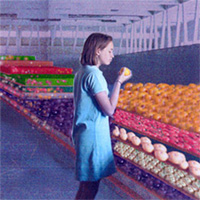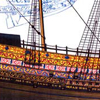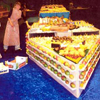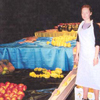The World of Fruit and Globalization, 2000
 |
With the collaboration of maritime consultants Barbara Trilling and Luciano Diez Canedo.
The World of Fruit and Globalization was presented at Images of the World, an international cultural festival concerning the consequences of globalization, in Copenhagen, Denmark, August 4, 2000.
This work, conceived by Alicia Rios and Gonzalo Sainz de Buruaga, consisted of a huge table-vessel, a stylization of a Flemish galleon designed by Angela Garcia de Paredes and Ignacio Pedrosa and based on an illustration of a Flemish galleon by Bjorn Landstrom. Loaded on top and around it were hundreds of kilos of fruit from all parts of the world.
The shape and content of the installation were determined by two events that were significant in the history of globalization.
- In 1522 Juan Sebastian Elcano returned to Seville after having circumnavigated the earth in three years; the spherical shape of the world thus confirmed as reality.
- In 1593 the subjects of Flanders offered King Felipe II of Spain the most beautiful galleon of the century.
These two events are very important economic and strategic factors, the second one in relation to the development of navigation. From then on the western world has shown countless times that the earth is round and that it can be traded and tasted like a rich fruit. Since that time, fruits and other products have been transported across the globe at ever increasing speed in order to reach their markets.
The fruit reflected, on the one hand, the unity of the global vessel and on the other, the deep injustice and differences that are still a destabilizing factor upon our vessel. These differences were present in the way the fruit was displayed in the installation. The First World steers the vessel and the fruit banquet; the Mediterranean serves the First World and the Third World is not even able to get the scraps of the banquet.
The table-ship was divided into seven sections corresponding to the different levels of political and economic power of our time, plus one more section, the holds, where the fruit began to perish, becoming a rotting and unique substance which was discarded and thrown into the ocean to disappear.
|





